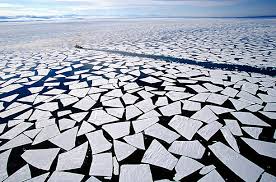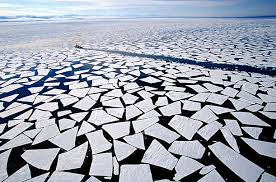
With scientists warning that climate change is having “profound effects” on the entire marine ecosystem and the indigenous communities that rely upon it, the Arctic experienced record air temperatures and a new low in peak ice extent during 2015.
The annual average air temperature in the Arctic circle was 1.3C (2.3F) above the long-term average, this was revealed in the latest report of the National Oceanic and Atmospheric Administration (Noaa). This average temperature is the highest since modern records began in 1900.
In some parts of the arctic circle, the temperature exceeded 3C (5.4F) above the average, taken from 1981 to 2010.
Diminishing ice accompanied this record heat. Since records began in 1979, the peak ice cover in the Arctic Ocean reached on February 25. This was 15 days earlier than the long-term average and the lowest extent since 1979. The minimum ice cover was the fourth smallest in area on record and occurred on 11 September.
With 22 of the 45 widest and fastest-flowing glaciers shrinking in comparison to their 2014 extent, there was melting in more than 50% of Greenland’s huge ice sheet in 2015.
Noaa’s analysis of satellite data shows that 70% of the ice pack in March was composed of first-year ice, with just 3% of the ice older than four years. This indicates that not only the ice was winnowing away but it is becoming younger. Scientists say that this newly formed ice has nearly doubled since the 1980s and is more vulnerable to melting.
There were sharp variations in conditions in the northern part of the Arctic compared to its southern portion, noted the report which was complied by 72 scientists from 11 countries. There is an impact of the colder air to cause more effect on the Southern part of the arctic suggesting there has been changes to the jet stream.
There has been an average increase of 2.9C (5.2F) over the past century as the Noaa scientists claim that warming in the Arctic is occurring at twice the rate of anywhere else in the world. Scientists are certain that this is effect of climate change that is driven by the emission of green house gases.
“There is a close association between air temperature and the amount of sea ice we see, so if we reduce the temperature globally it looks like it will stabilize the Arctic,” said Dr James Overland, oceanographer at Noaa.
“The next generation may see an ice-free summer but hopefully their decedents will see more ice layering later on in the century,” he said.
The Arctic will experience a 4C (7.2F) to 5C (9F) increase in temperature by 2050 if the world hits the 2C (3.6F) warming limit agreed by nations in the recent Paris climate talks, Overland said.
The greatest impact has been noticed in the Chukchi Sea, by Alaska, which is claimed to be warming the fastest of any of the Arctic waters where the overall minimum ice extent has slumped by 13.4% a decade, on average.
According to Rick Spinrad, Noaa’s chief scientist, the changes in the Arctic are also causing “major challenges” for the indigenous communities in the region. While an increase in sunlight reaching the upper layers of the ocean triggered widespread blooms of algae in the Bering Sea, between Alaska and Russia, in 2015, warmer-water fish such as cod are moving north, displacing Arctic species.
(Source:www.theguardian.com)
The annual average air temperature in the Arctic circle was 1.3C (2.3F) above the long-term average, this was revealed in the latest report of the National Oceanic and Atmospheric Administration (Noaa). This average temperature is the highest since modern records began in 1900.
In some parts of the arctic circle, the temperature exceeded 3C (5.4F) above the average, taken from 1981 to 2010.
Diminishing ice accompanied this record heat. Since records began in 1979, the peak ice cover in the Arctic Ocean reached on February 25. This was 15 days earlier than the long-term average and the lowest extent since 1979. The minimum ice cover was the fourth smallest in area on record and occurred on 11 September.
With 22 of the 45 widest and fastest-flowing glaciers shrinking in comparison to their 2014 extent, there was melting in more than 50% of Greenland’s huge ice sheet in 2015.
Noaa’s analysis of satellite data shows that 70% of the ice pack in March was composed of first-year ice, with just 3% of the ice older than four years. This indicates that not only the ice was winnowing away but it is becoming younger. Scientists say that this newly formed ice has nearly doubled since the 1980s and is more vulnerable to melting.
There were sharp variations in conditions in the northern part of the Arctic compared to its southern portion, noted the report which was complied by 72 scientists from 11 countries. There is an impact of the colder air to cause more effect on the Southern part of the arctic suggesting there has been changes to the jet stream.
There has been an average increase of 2.9C (5.2F) over the past century as the Noaa scientists claim that warming in the Arctic is occurring at twice the rate of anywhere else in the world. Scientists are certain that this is effect of climate change that is driven by the emission of green house gases.
“There is a close association between air temperature and the amount of sea ice we see, so if we reduce the temperature globally it looks like it will stabilize the Arctic,” said Dr James Overland, oceanographer at Noaa.
“The next generation may see an ice-free summer but hopefully their decedents will see more ice layering later on in the century,” he said.
The Arctic will experience a 4C (7.2F) to 5C (9F) increase in temperature by 2050 if the world hits the 2C (3.6F) warming limit agreed by nations in the recent Paris climate talks, Overland said.
The greatest impact has been noticed in the Chukchi Sea, by Alaska, which is claimed to be warming the fastest of any of the Arctic waters where the overall minimum ice extent has slumped by 13.4% a decade, on average.
According to Rick Spinrad, Noaa’s chief scientist, the changes in the Arctic are also causing “major challenges” for the indigenous communities in the region. While an increase in sunlight reaching the upper layers of the ocean triggered widespread blooms of algae in the Bering Sea, between Alaska and Russia, in 2015, warmer-water fish such as cod are moving north, displacing Arctic species.
(Source:www.theguardian.com)





